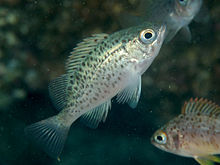Sebastes ventricosus
| Sebastes ventricosus | |
|---|---|

| |
| Scientific classification | |
| Domain: | Eukaryota |
| Kingdom: | Animalia |
| Phylum: | Chordata |
| Class: | Actinopterygii |
| Order: | Perciformes |
| Family: | Scorpaenidae |
| Genus: | Sebastes |
| Species: | S. ventricosus |
| Binomial name | |
| Sebastes ventricosus | |
Sebastes ventricosus, the Japanese black seaperch or Japanese blueback seaperch, is a species of marine ray-finned fish belonging to the subfamily Sebastinae, the rockfishes, part of the family Scorpaenidae. It is found in the northwestern Pacific Ocean. In Japan this species is known as Mebaru(メバル/鮴).
Taxonomy
Sebastes ventricosus was first formally described in 1843 by the zoologists Coenraad Jacob Temminck and Hermann Schlegel with the type locality given as Nagasaki.[1] Together with S. inermis and S. cheni these three taxa form a species complex and have been treated as a single species in the past.[2] Some authorities place this species complex in the subgenus Mebarus. The specific name ventricosus means "potbellied or bulging", an allusion which was not explained by the authors nor is it evident what it refers to, it may be alluding to the rounded nape or possibly the ventral profile which is shown as bulging in the plate accompanying the description.[3]
Description
Sebastes ventricosus is greenish-black on the upper body and dark silver on the lower body. The pectoral-fin has 16 rays, the anal-fin has 7–8 soft rays and there are 43-49 pored scales in the lateral line.[2]
Distribution and habitat
Sebastes ventricosus has been recorded from Iwate and Ishikawa Prefectures south to Kyushu in Japan, and off the southern part of the Korean Peninsula.[2] It is a marine, demersal fish.[4]
Sea perch fishing
Sea perch are very popular seawater game fish highly prized especially by fishermen, because they generally put up a good fight when caught with a hook and line. As sea perch are predatory fish, lure fishing (which use replica baits called lures to imitate live prey) is the predominant form of sport fishing involving sea perch, although traditional bait fishing techniques using floats and/or sinkers (particularly with moving live baits such as baitfish, krill or shrimp) are also successful.
It is recommended that when fishing for sea perch, that the fisher(s) should use line in the 1–5 lb test for sea perch. It is also recommended to use a hook size 8-5 for sea perch of all kind. Sea perch, tend to like ragworms, minnows, or cut bait.
References
- ^ Eschmeyer, William N.; Fricke, Ron & van der Laan, Richard (eds.). "Species in the genus Sebastes". Catalog of Fishes. California Academy of Sciences. Retrieved 16 December 2021.
- ^ a b c Yoshiaki Kai; Tetsuji Nakabo (2008). "Taxonomic review of the Sebastes inermis species complex (Scorpaeniformes: Scorpaenidae)". Ichthyological Research. 55 (3): 238–259. Bibcode:2008IchtR..55..238K. doi:10.1007/s10228-007-0029-7.
- ^ Christopher Scharpf & Kenneth J. Lazara, eds. (22 May 2021). "Order Perciformes (Part 8): Suborder Scorpaenoidei: Families Sebastidae, Setarchidae and Neosebastidae". The ETYFish Project Fish Name Etymology Database. Christopher Scharpf and Kenneth J. Lazara. Retrieved 16 December 2021.
- ^ Froese, Rainer; Pauly, Daniel (eds.). "Sebastes ventricosus". FishBase. August 2021 version.
External links
 Media related to Sebastes ventricosus at Wikimedia Commons
Media related to Sebastes ventricosus at Wikimedia Commons Data related to Sebastes ventricosus at Wikispecies
Data related to Sebastes ventricosus at Wikispecies
